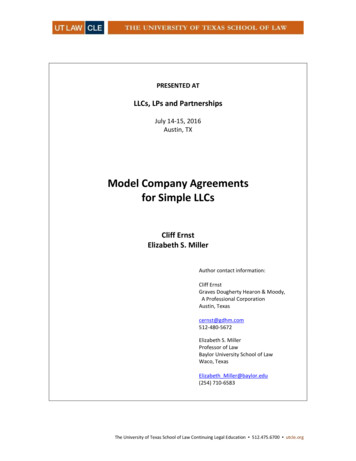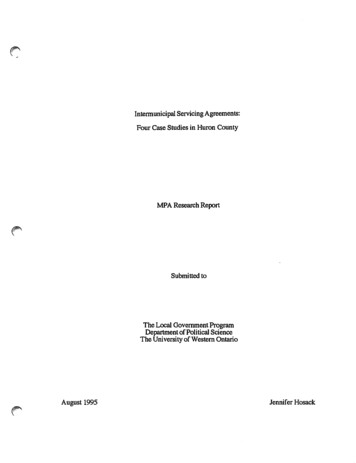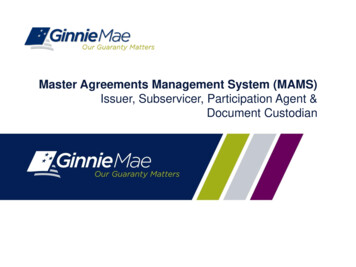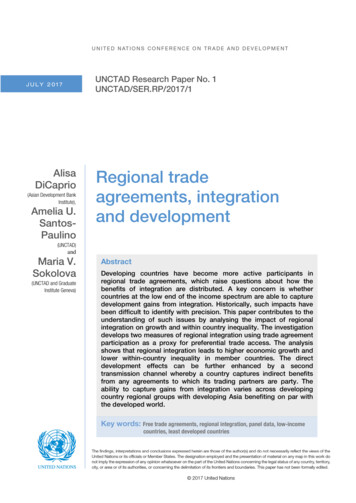
Transcription
PRESENTED ATLLCs, LPs and PartnershipsJuly 14-15, 2016Austin, TXModel Company Agreementsfor Simple LLCsCliff ErnstElizabeth S. MillerAuthor contact information:Cliff ErnstGraves Dougherty Hearon & Moody,A Professional CorporationAustin, Texascernst@gdhm.com512-480-5672Elizabeth S. MillerProfessor of LawBaylor University School of LawWaco, TexasElizabeth Miller@baylor.edu(254) 710-6583The University of Texas School of Law Continuing Legal Education 512.475.6700 utcle.org
Model Company Agreementsfor Simple LLCsTable of ContentsPageI.Introduction .1II.Company Agreements Generally .2III.The Model Agreements .3IV.A.Introductory Paragraph .3B.Article 1: Formation .5C.Article 2: Members and Membership Interests .7D.Article 3: Management of the Company, Meetings and Voting .19E.Article 4: Capital Contributions. .23F.Article 5: Taxation and Allocations.26G.Article 6: Distributions .27H.Article 7: Bank Account, Books of Account, Reports and Fiscal Year .28I.Article 8: Transfer Restrictions and Push Pull Provisions .32J.Article 9: Exculpation, Indemnification and Advancement .33K.Article 10: Winding Up .44L.Article 11: Miscellaneous Provisions and Definitions .46Conclusion .48Appendix A – Model Company Agreement for Manager-Managed, Multi-Member LimitedLiability Company AgreementAppendix B – Model Company Agreement for Member-Managed, Multi-Member LimitedLiability Company AgreementAppendix C – Model Company Agreement for Single Member Limited Liability CompanyAgreement
Model Company Agreementsfor Simple LLCsCliff ErnstGraves Dougherty Hearon & Moody,A Professional CorporationAustin, TexasElizabeth S. MillerProfessor of LawBaylor University School of LawWaco, TexasI.Introduction.Records maintained by the Texas Secretary of State indicate that the limited liabilitycompany has become the entity of choice among Texas organizations. The office of the TexasSecretary of State reports that of the 157,248 certificates of formation filed for domestic forprofit entities in 2014, 126,092 (or approximately 80%) were limited liability companies and ofthe 165,026 certificates of formation filed for domestic for-profit entities in 2015, 135,250 (orapproximately 82%) were limited liability companies.1It is often stated that one of the benefits of organizing an entity as a limited liabilitycompany is that this form of entity offers the owners and governing authority of the entity theflexibility to agree to provisions for the economic terms and governance that are more flexiblethan available with respect to a corporation. This is true, and indeed limited liability companiesare sometimes used to create highly complex structures with multiple classes of ownershipinterests and highly customized provisions regarding management and governance of the entity,including complicated provisions for voting and management succession. However, given thelarge number of entities now being created as limited liability companies in Texas and otherstates, it is likely that many of these new entities are not entities with complex structures withmultiple classes of ownership and complex bureaucracies for governance. Statistics compiled bythe Internal Revenue Service show that for the tax year 2013 (the most recent year for which1The office of the Texas Secretary of State has provided to the authors the following information aboutnumbers of certificates of formation or initial registrations filed for domestic entities:For-Profit CorporationsLimited Liability CompaniesLimited PartnershipsLimited Liability 5,2505,676741
statistics are currently available), over 63% of the S corporation returns are for singleshareholder S corporations and over 27% have only two shareholders.2 The Internal RevenueService does not publish similar statistics for limited liability companies, and of course singlemember limited liability companies are typically disregarded entities that do not file tax returns.But if one assumes that most limited liability companies are closely held entities, then byanalogy, it is likely that a large portion of limited liability companies have one or two owners.Therefore, it is much more likely that practitioners will find themselves needing to draft simplelimited liability company agreements suitable for entities with one or two or a very few owners,rather than more complex documents.The purpose of this paper is to present and discuss models for governing agreements forlimited liability companies when a simple structure is needed.II.Company Agreements Generally.As with other filing entities under the Texas Business Organizations Code (“BOC”),3 aTexas limited liability company is created by the filing of a certificate of formation meeting therequirements of BOC §3.005 and §3.010. The existence of the company commences when thefiling of the certificate takes effect as provided in BOC Chapter 4.4The BOC does not expressly require that a Texas limited liability company have acompany agreement, but it is difficult to conceive of a situation in which there would not besome skeletal agreement of the members regarding the conduct and affairs of the limited liabilitycompany.5 The statute expressly recognizes that a company agreement may be written or oral.6However, it is obviously advisable for a limited liability company to have a written companyagreement to provide certainty and avoid ambiguity about the ownership and management of EX. BUS. ORGS. CODE ANN. § 1.001 ET SEQ. (WEST, WESTLAW through Ch. 46 of 2015 Legis. Sess.).4TEX. BUS. ORGS. CODE ANN. § 3.001(c).5Inasmuch as the BOC recognizes oral as well as written company agreements, a course of dealing mayreflect the company agreement of the members on some matters. Furthermore, any provision that may be containedin the company agreement may be included in the certificate of formation. TEX. BUS. ORGS. CODE ANN. §101.051(a). Even a very basic certificate of formation would seemingly constitute a company agreement as tocertain items, such as the name of the company, the type of management (i.e., member-managed or managermanaged), and the identity of the initial members or managers.6TEX. BUS. ORGS. CODE ANN. § 101.001(1) (defining “company agreement” as “any agreement, written ororal, of the members concerning the affairs of a limited liability company”).2
It should be noted that in the event of a conflict between the language of the certificate offormation and the company agreement, the language of the certificate of formation will govern.7Most practitioners have moved away from the practice of including long substantive provisionsin the certificate of formation, and indeed many are comfortable using the simple form ofcertificate promulgated by the Secretary of State.8 In the past it was more common to addressissues such as indemnification or written consents in lieu of meetings in the filing made with theSecretary of State. Since the owners of the entity do not need to sign the certificate and may notsee or focus on substantive provisions in the certificate, care should be given that any suchprovisions do not unintentionally override the provisions of the company agreement.III.The Model Agreements.A.Introductory Paragraph.As with almost all agreements, the introductory paragraph of a company agreementtypically states the parties to the agreement and the date or effective date of the agreement. Themembers of the limited liability company are always parties to the company agreement.Generally, even in a manager-managed limited liability company whose certificate offormation does not identify the initial members, the identities of one or more initial members willbe understood at the time a limited liability company is formed, and it is prudent for the initialmembers to execute a written company agreement prior to or contemporaneously with the filingof the certificate of formation so that it is clear who the members are and what their economicand governance rights are. The BOC expressly recognizes, however, the formation of a limitedliability company that does not initially have any members, sometimes referred to as a “shelf”limited liability company. Under this provision, an organizer may file a certificate of formationthat identifies one or more initial managers, but the limited liability company need not have anymembers for a “reasonable period” after the limited liability company is formed.9While it is possible to utilize a “shelf” limited liability company, there are some questionsassociated with such a practice. First, what is a “reasonable period” after the filing of thecertificate of formation? Is it merely a temporal concept or does it also relate to the activitiesundertaken by the limited liability company? Presumably, the managers may undertake certainactions to facilitate the organization of the limited liability company and securing of investors,but it would be unwise to transact significant business prior to the admission of members. What7TEX. BUS. ORGS. CODE ANN. § 101.052(d). See Pinnacle Data Servs., Inc. v. Gillen, 104 S.W.3d 188 (Tex.App. – Texarkana 2003, no pet.) (holding voting provision in limited liability company’s articles of organizationcontrolled over conflicting voting provision contained in the company’s s boc.shtml.9TEX. BUS. ORGS. CODE ANN. § 101.101(b) (stating that a limited liability company that has managers is notrequired to have members during a “reasonable period between the date the company is formed and the date the firstmember is admitted to the company”). See also TEX. BUS. ORGS. CODE ANN. § 101.356(e) (providing that memberapproval is not required for an action during the reasonable period that a manager-managed limited liabilitycompany is permitted not to have any members after formation).3
is the tax classification of a limited liability company without members? If the limited liabilitycompany undertakes any significant business and there is then a failure to obtain members or adispute as to whether there are members and who they are, this could be a thorny situation.At the point that there are persons who desire to be members in a limited liabilitycompany that has previously been formed but has no members, may they simply execute acompany agreement identifying themselves as the members and thereby become members “inconnection with the formation” of the limited liability company? It would appear so, but what ifthere is a dispute as to who the members will be, i.e., a fight over the limited liability company?If two factions each execute a company agreement claiming to be the members, who determineswhich is the company agreement of the limited liability company? Inasmuch as becoming amember “in connection with the formation of the limited liability company” when one is notnamed as an initial member in the certificate of formation depends upon a reflection of theperson’s membership in a limited liability company “record,”10 it appears that the manager ormanagers may have a role in determining which company agreement is the company “record” ofmembership.If after the filing of the certificate of formation of a limited liability company asubstantial period of time elapses without the admission of members, the question might arisewhether a person who desires to become a member must do so in accordance with the statutoryprocedures applicable “after the formation” of the limited liability company. This result wouldbe problematic because the statute requires that a person becoming a member after formation ofthe limited liability company must do so with the consent of all members unless a companyagreement provides otherwise.11 It would be impossible to admit a member under suchcircumstances because the limited liability company has no members and thus no companyagreement.12 It is more logical to interpret the statute as permitting persons to become members“in connection with the formation” of the limited liability company if the limited liabilitycompany has previously existed as a memberless shell entity, even if a substantial period of timehas passed since the filing of the certificate of formation.The model agreement presented with this paper for a company agreement for a singlemember limited liability company has only one party, the single member. It is of course notcustomary for a person to make an agreement with oneself, but BOC § 101.001(1) anticipatedthis situation and provides that a company agreement of a limited liability company with onlyone member is not unenforceable because only one person is a party to the agreement.BOC § 101.052 provides that the company agreement of a limited liability companygoverns the relationship among the members, managers and officers, assignees of interests in thecompany and the company itself. The managers have certain duties spelled out in the company10TEX. BUS. ORGS. Code ANN. § 101.103(b).11TEX. BUS. ORGS. Code ANN. §§ 101.052, 101.103(c).12The company agreement is defined as “any agreement, written or oral, of the members concerning theaffairs or the conduct of the business of a limited liability company.” TEX. BUS. ORGS. CODE ANN. § 101.001(1).4
agreement and typically are also entitled to exculpation and indemnification under theagreement. (See Section III.J. below.) The authors have not included the managers as parties tothe model agreement presented with this paper for a limited liability company managed bymanagers. If an entity has a single manager whose duties and relationship with the entity aresimilar to the role of a general partner of a partnership or if the manager has specific contractualbenefits and obligations (such as earning a management fee) that need to be spelled out in theagreement, then it might be appropriate to make the manager a named party and have it sign thecompany agreement.The duties of officers may be spelled out in a company agreement, and often theexculpation and indemnification provisions extend to officers, if any (as do the provisions of themodel agreements included with this paper). Nevertheless, it does not seem to be standardpractice to make officers parties to the company agreement.The question is sometimes raised whether the company itself is or should be a party to thecompany agreement. As noted above, BOC § 101.052 provides that the company agreementgoverns the relationship among owners, management, and the company. Thus, absent an expressprovision in the company agreement indicating a contrary intent on the part of the members, acourt should find that a Texas limited liability company is bound by and has the benefits of thecompany agreement even though it is couched as an agreement among the members.13 We haveincluded a provision in the model company agreements accompanying this paper detailing thepersons (including the company itself) that are bound by, and beneficiaries of, the terms of theagreement.14 That provision also states that creditors are not third-party beneficiaries.B.Article 1: Formation.The first article of the model agreements presented with this paper contains provisionsdealing with the formation and structure of the company including its name, duration, purpose,principal office and name and address of the registered agent.BOC § 3.003 states that a domestic entity (including a limited liability company) willhave perpetual existence unless provided otherwise in its governing document or terminated bylaw. While it may sometimes be the desire of the parties for a limited liability to exist for a finitetime such as until the completion of a venture project or the sale of an asset, it is usually theexpectation of the parties that the company will have perpetual existence unless otherwise agreedby the members. The model agreements included with this paper provide that the company will13In Seven Hills Commercial, LLC v. Mirabal Custom Homes, Inc., 442 S.W.3d 706 (Tex. App. – Dallas2014, pet. denied), the court of appeals relied on BOC § 101.052(a)(1) in concluding that a limited liability companycould enforce an arbitration clause in the company agreement even though the limited liability company was not asignatory to the agreement.14Section 11.6 of Appendix A and Appendix B and Section 11.4 of Appendix C.5
exist until terminated as provided in the Agreement.15 Detailed provisions for the winding upand termination of the company are set forth later in the agreement.16BOC § 3.005(a)(3) requires that a filing entity (including a limited liability company)state in its certificate of formation the purpose or purposes for which the entity is being formed,but a statement of “any lawful purpose” is allowed. It is standard practice for the certificate offormation to state the purpose as any lawful purpose and not contain a detailed description of thepurpose or proposed business of the entity. Concerns regarding the relationship between thepurpose clause and the business opportunity doctrine and the scope of an agent’s apparentauthority may lead to use of a narrow or specific purpose clause in the certificate of formation,but in view of uncertainty as to how the ultra vires doctrine applies to limited liabilitycompanies,17 many practitioners prefer to include the standard broad purpose clause in thecertificate of formation and include more specific provisions in the company agreement.18There may be many reasons to state a more specific purpose in the company agreement,including setting clear expectations regarding the scope of business that the parties are agreeingto invest in and/or manage. Stating a specific purpose in the company agreement may also15Section 1.3 of Appendix A, Appendix B and Appendix C.16Article 10 of Appendix A, Appendix B and Appendix C.17The BOC provides that the statute does not grant authority to a domestic entity or its managerial officials toact outside the scope of the purposes of the entity. TEX. BUS. ORGS. CODE ANN. § 2.113(a).18There may be a concern on the part of the managers or members that stating the purpose of the limitedliability company in the certificate of formation as “any lawful business” exposes them to more potential liability inthe area of usurpation or appropriation of a company opportunity. Presumably, managers or managing membershave a duty of loyalty similar to officers and directors of a corporation and partners in a partnership not to take forthemselves a business opportunity that fairly belongs to the entity. The scope or line of business of the corporationor partnership is an important consideration in determining whether this duty has been breached. A narrowly definedpurpose clause similar to the type of specific statement of the business often found in partnership agreements wouldcertainly be relevant in defining the scope of business. It does not necessarily follow, however, that a broad purposeclause in the certificate of formation results in every opportunity being encompassed in the scope or line of thelimited liability company's business. Certainly, there is no indication in the corporate opportunity cases that a broadpurpose clause in the articles of incorporation or corporate certificate of formation brings every business opportunitywithin the corporation's line of business and precludes an officer or director from entering into any personal businesstransactions. Fiduciaries of a limited liability company should be able to defeat such an argument by pointing outthat courts in both the corporate and partnership context have focused on the business actually engaged in by thecorporation or partnership. In view of this concern, however, a narrower purpose clause in the limited liabilitycompany’s certificate of formation may be desirable in some cases, or it may be desirable to temper an “any lawfulpurpose” or “any and all lawful business” purpose clause in the certificate of formation with a statement in thecompany agreement regarding the anticipated scope of the business and the intended bounds of the businessopportunity doctrine.Another concern that may motivate use of a narrow purpose clause in the certificate of formation is the scope ofactual or apparent authority of the managers, managing members, or other agents of the company. See TEX. BUS.ORGS. CODE ANN. § 101.254. Again, however, including in the certificate of formation a purpose clause phrased interms of “any lawful purpose” or “any and all lawful business” should not cause every transaction to be encompassedin the “ordinary course” of business. Such certainly is not the case in the corporate context. Nevertheless, anabundance of caution in this area may lead to a preference for a narrower purpose clause or, as suggested above, astatement in the company agreement as to the more specific nature of the business.6
protect the owners and governing persons from later claims related to a breach of a duty ofloyalty to the entity or owners. If the purpose is stated to be one of relatively narrow scope, thenactivities outside the scope may be less likely to provoke claims that these activities werebusiness opportunities that should have been offered to the company.19 A specific description ofthe company’s purpose may also be desirable with respect to interpretation of provisions of theagreement that refer to the “ordinary course of business” of the company.The model agreements presented with this paper assume that the agreement will include asomewhat specific statement regarding the purpose and proposed business of the company alongwith a more general “catch-all” provision allowing related activities.20Company agreements, especially those for complex transactions, may make use ofnumerous defined terms. Often these defined terms appear at the beginning of the governingagreement. While the model agreements included with this paper do not use a large amount ofdefined terms, we have placed the defined terms at the end of the agreement so that the readerdoes not become bogged down in pages of technical definitions before finding the parts of theagreement that spell out the business terms. Because defined terms do frequently appear at thebeginning of these agreements, to avoid confusion there is a reference in the model agreementsto the section at the end of the agreement where the defined terms appear.21C.Article 2: Members and Membership Interests.This article of the model agreements deals with matters related to members andmembership interests, including admission of new members.The model agreements presented with this paper provide that the initial members areadmitted as members as of the date of formation of the company.22 For a member-managedentity, the initial member or members are named in the certificate of formation and are thereforeknown when the company is formed by filing its certificate of formation. (See Section III.B.above.) If the company agreement is not being executed more or less contemporaneously withthe filing of the certificate of formation, it may be appropriate to provide that founding memberswho sign after the filing are admitted as members effective upon their execution of the companyagreement. (See Section III.A. above.) If some founding members sign the company agreementupon filing of the certificate of formation and others sign later, this may create furthercomplexities for the drafter including how to allocate profits and losses, if any, incurred betweenthe date of filing and the later effective date of admission and how to document that the memberswho sign at filing have approved the admission of the members who sign later. In view of thescope intended for the model agreements included with this paper, a simple transaction amongone or a few owners, the authors have assumed that the founding members would be known at19See the discussion in the previous footnote.20Section 1.4 of Appendix A, Appendix B and Appendix C.21Section 1.7 of Appendix A, Appendix B and Appendix C.22Section 2.1 of Appendix A, Appendix B and Appendix C.7
the time the company is formed, that they would all sign the company agreement and make theircapital contributions to the company more or less simultaneously with filing the certificate offormation, and that it would be reasonable and consistent with the expectations of the parties todeem that membership commences upon the date of formation.BOC § 101.104 permits limited liability companies to have multiple classes ofmembership interests with differing rights, including voting rights, as set forth in the companyagreement. As mentioned at the outset of this paper, limited liability companies are oftenutilized to set up entities with complex tiers or classes of ownership. Because the scope of thispaper is to focus on agreements for simple business structures, the model agreements includedwith this paper do not contemplate multiple classes of ownership interests. The modelagreements assume that there will only be one class of ownership interest and that all memberswill have the same rights and obligations with regard to their ownership except the rightsassociated with owning a greater percentage than other members.The model agreements for companies with multiple owners use the concept and definedterm “Percentage” throughout the agreements to specify the relative percentage ownership of themembers. The agreements contemplate the Percentages of the owners would be agreed at thetime of formation and execution of the company agreement and specified in an exhibit to theagreement.23 If new membership interests are issued or existing interests are transferred, thePercentages would need to be adjusted by agreement of the parties.24 Although it may seem likean obvious proposition, the definition of “Percentage” in the multi-member model agreementsexpressly provides that the total Percentages of membership interests owned by all Members andassignees at any point in time shall equal 100%. If a member’s interest is bought out by thelimited liability company, there is sometimes confusion and disagreement among the members asto whether the interest should be treated as a “treasury interest.” The concept of “treasuryinterests” could be created by the company agreement, but the concept is not really contemplatedas a default rule in the limited liability company statute and is not intended to apply under themodel agreements. It might prove useful for the drafter to review with the members someexamples of various types of adjustments in percentages before the agreement is executed, or thedrafter might even choose in some cases to include examples in the definition.25 BOC § 101.50123Section 2.1 of Appendix A and Appendix B.24Section 2.2 of Appendix A and Appendix B.25The following examples illustrate the operation of the definition of “Percentage” under the modelagreements:(1) The Percentages of Members A, B and C are 33 1/3% each. Member C dies, and theCompany purchases Member C’s interest from Member C’s estate. The Percentages ofthe remaining Members are as follows: Member A 50% and Member B 50%.(2) The Percentages of Members A, B and C are as follows: Member A 40%, Member B20% and Member C 40%. Member C dies, and the Company does not purchase MemberC’s interest from Member C’s estate; therefore, Member C’s estate (and heir(s) ordevisee(s) upon distribution from the estate) is an assignee. After Member C’s death, thePercentages are as follows: Member A 40%, Member B 20% and Member C’s estate40%. However, for purposes of Sections 3.14 and 3.15 of Appendix A and Section 3.10(Footnote continued on the next page)8
requires a Texas limited liability company to maintain records of the percentage or other interestin the company owned by each member. These provisions of the model company agreementsshould satisfy that requirement.Under the BOC, a membership interest is assignable “wholly or partly,”26 but assignmentof a membership interest involves the transfer of economic rights, not a transfer of membershipstatus. Assignment of a membership interest does not trigger winding up of the limited liabilitycompany, and it does not confer upon the assignee any management rights or entitle the assigneeto become or exercise the rights of a member.27 An assignee of a membership interest is entitledto be allocated, to the extent assigned, the income, gain, loss, deduction, credit, and similar itemsassociated with the interest.28 An assignee is also entitled to receive, to the extent assigned,distributions to which the assignor was entitled.29 Finally, an assignee is entitled to requirereasonable information and to make reasonable inspection of the books and records of the limitedliability company.30 An assignee does not have liability as a member by virtue of the assignmentof the interest.31Just as the assign
Texas limited liability company iscreated by the filing of a certificate of formation meeting the requirements of BOC §3.005 and §3.010. The existence of the company commences when the filing of the certificate takes effect as provided in BOC Chapter 4.4 The BOC does not expressly require that a Texas limited liability company have a











